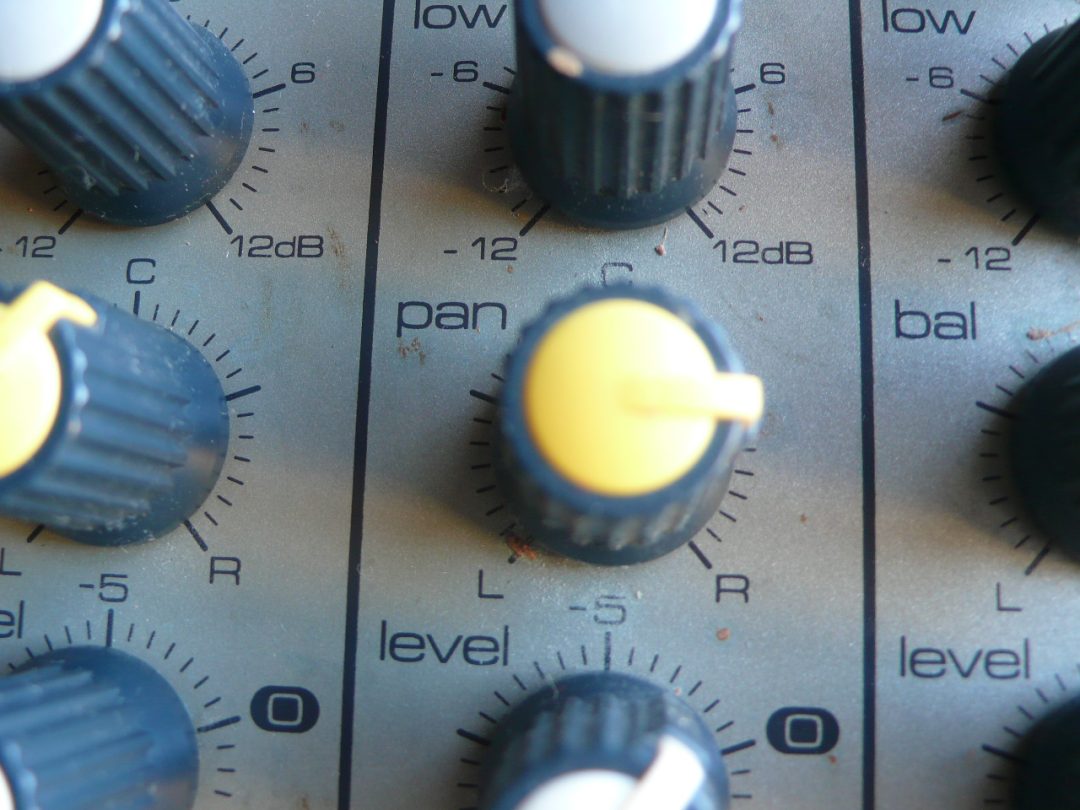Panning is an essential part of every mix. Placing elements throughout the stereo field creates space and width, and can make things sound HUGE in the right context.
What Is Panning in Music?
Panning is the process of moving things to the left and right speakers, or leaving them in the center. This is what we refer to as the stereo field, or the stereo image of a song.
While there are no definitive “rules” to mixing and music production, conventional wisdom tells us that this is an early part of a mix. At least getting a rough placement of every instrument and mix element is usually one of the first we things we do after setting rough levels.
What Is a Pan Potentiometer?
The pan pot controls how much signal we’re sending to the left speaker, or the right speaker, or leaving in the middle. Leaving the pan pot at 0, or right in the middle, means that both speakers receive equal amounts of the signal. When we start to move the pot, we’re giving one speaker more signal than the other.
Hard Panning vs. Soft Panning
Hard panning is a term we use for 100% in either direction. Hard left or hard right. With double-tracked rhythm guitars, for example, it’s common practice to pan one track all the way left and one all the way right. The result is fullness and stereo width that sounds really massive.
On the other hand, soft panning just refers to moving elements around but not committing to 100% left or right. You can move things a little bit this way or that way to get them out of the center without having a super distracting hard pan.
What Should I Leave At Center Pan?
A lot of core mix elements stay in the center. Kick, snare, bass/subs, lead vocals, things like a guitar solo, etc. Mono elements that make up the foundation of a song typically stay in the center. As is always the case with music production, a little experimentation goes a long way in regards to understanding these fundamental concepts!
Quick Tips For Panning Your Mix
Judicious application of panning can really go a long way. It’s a really simple tool that does loads for how big and full a mix sounds, plus you can do a lot of clever ear candy type bits with the pan pot.
Know Your Center
First and foremost, just because we can pan things doesn’t always mean we should. We mentioned several instruments that should live in the middle because they form the heart of the song.
Something to keep in mind is that when we pan stuff, it usually makes it stand out to listeners. When you can locate a singular sound coming from the left or the right side, it draws attention to itself. This can be a great or not-so-great thing depending on the situation.
Automation Is Your Friend
An awesome production and mix takes listeners on a journey. One way to add interest to a mix is by automating your stereo field. So maybe you have a pre-chorus vocal that comes from the left channel before dropping center into the hook. Or maybe you want to do a really drastic effect and automate an instrument back and forth between the left and right channels. The takeaway here is that panning doesn’t have to be stagnant.
“Visualize” Your Sound
Visualizing your sound means picturing all of the instruments in a room. Now imagine yourself sat in front of the band; where are the sounds coming from physically? Where do you want listeners to locate each element of your mix? Do you have the lead guitarist way off in the right-hand corner, or are they up front and center? Ask yourself questions like these when visualizing.
The best way to get into the practice of this is with drums. There are two approaches to panning drums, and it’s from either audience perspective or drummer’s perspective. With kick and snare in the center, we then have to decide where to move the hi-hat and the toms; overheads are usually recorded stereo, so we can do a hard (or soft) pan with those.
Drummer’s perspective pushes hi-hats slightly to the left, with each tom progressively going more right. Audience perspective is the opposite. Play around with it!
Panning to EQ
Sometimes when we have instruments with similar frequency content, the easiest way to let them breathe is to literally get them out of each other’s way. Before you start cutting frequencies, see if you can first sprinkle them throughout the stereo field.
Less Is Usually More
Hard panning all over the place (for no reason other than the sake of using the pan pot) generally isn’t a good approach. You want to be thoughtful with placement — not just panning because you “should.”
Actually, that’s a pretty good lesson for mixing overall. The more thoughtful we are, the more we mix with purpose, and the better our work can be!
